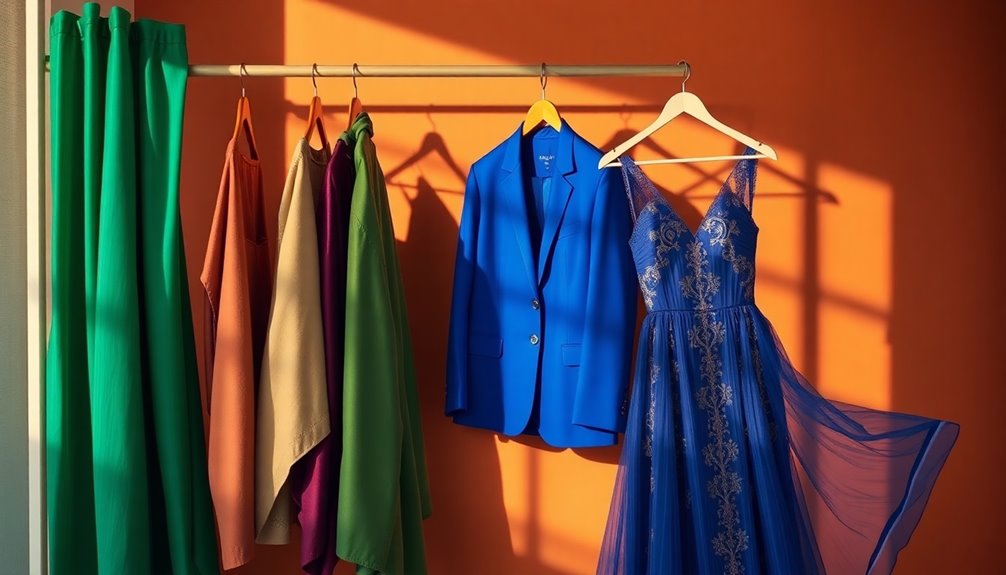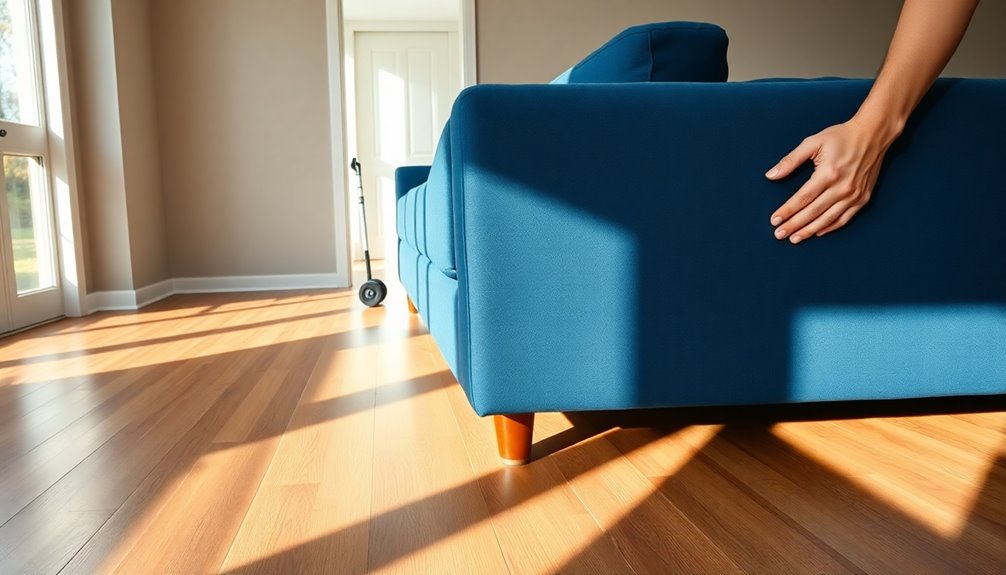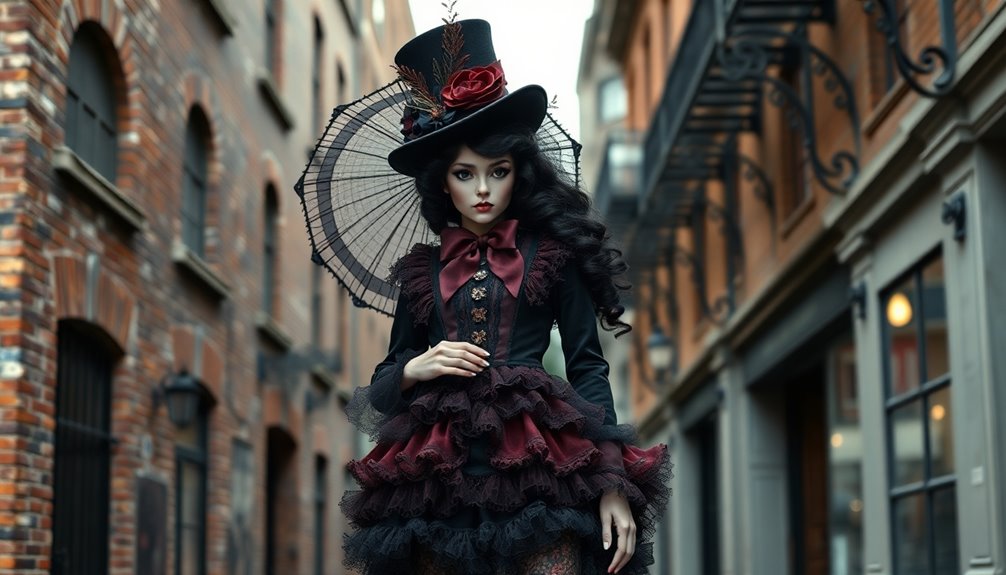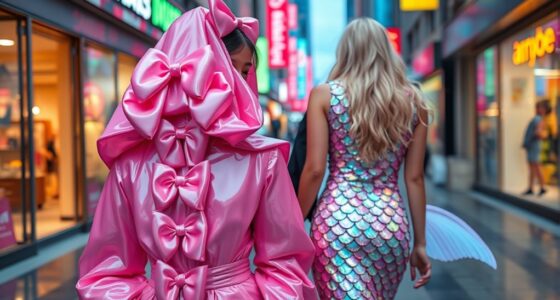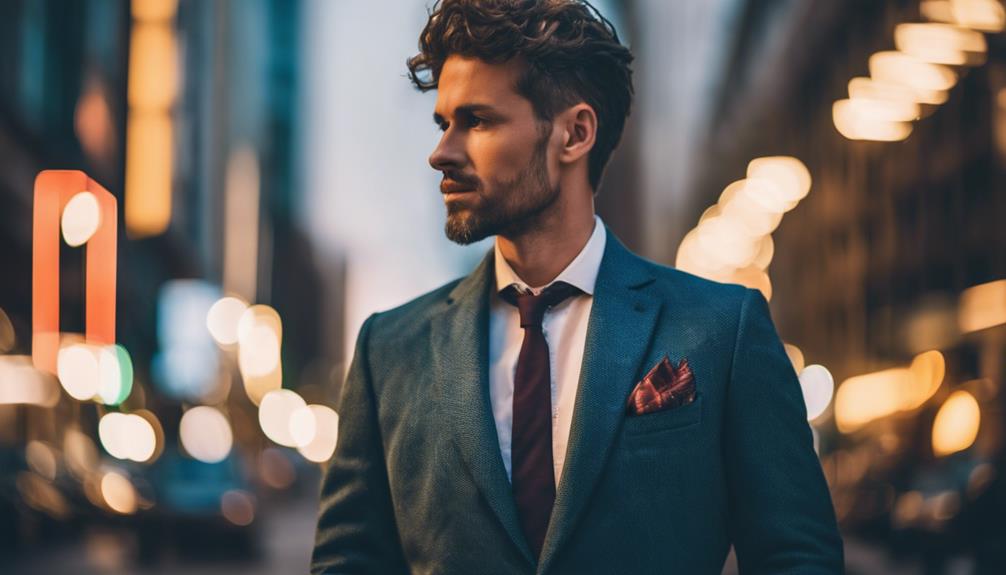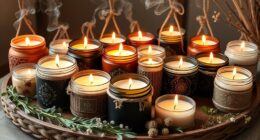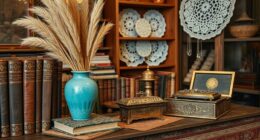Renaissance color palettes can truly elevate your contemporary wardrobe. With rich hues like emerald green and sapphire blue, you can express sophistication and style. Earthy tones such as terracotta make for a charming, rustic appeal, perfect for casual wear. Think about adding gold accents for a touch of opulence in everyday outfits. You can even elevate business attire with deep crimson or maroon accents, keeping history alive in your fashion choices. By blending these stunning colors into your looks, you not only embrace timeless elegance but also discover how they resonate with modern aesthetics. Explore these vibrant options further!
Key Takeaways
- Modern fashion incorporates vibrant Renaissance colors like terracotta and sapphire blue to evoke sophistication and opulence in contemporary wardrobes.
- Earthy tones, inspired by the Renaissance, enhance minimalist styles and add depth to casual outfits with rustic charm.
- Accessories in rich hues, such as emerald green or gold, elevate simple looks, reflecting the era's luxurious aesthetic.
- Monochrome outfits can be accentuated with bold Renaissance colors, creating visual interest and enhancing personal style.
- The timeless appeal of Renaissance palettes allows for diverse interpretations, blending historical influences with modern fashion trends.
Dominant Colors of the Renaissance

The vibrant color palettes of the Renaissance played a crucial role in both art and fashion, transforming how people expressed status and emotion. Dominant colors like terracotta, sapphire blue, and emerald green were more than mere aesthetics; they signified wealth and social stature. For instance, terracotta's warm, earthy hue connected wearers to nature, while sapphire blue was often associated with royalty, embodying luxury.
Crimson, a deep, intense red, was another favorite, frequently linked to high social status. Gold, used in accessories and garments, symbolized opulence and prestige. These colors weren't just chosen randomly; they carried emotional weight and cultural significance. Certain pigments were particularly valued by artists due to their cost, indicating an artist's stature and enhancing the visual narrative of their work. The use of green tea in traditional ceremonies reflects the importance of color and symbolism in various cultures, much like the Renaissance palette.
In art, techniques like sfumato and chiaroscuro utilized these pigments to evoke specific moods, capturing the era's fascination with beauty and realism. Creating these colors was an elaborate process, often involving costly materials like cochineal insects for red hues. This made vibrant clothing a statement of wealth, prompting recycling and reuse of textiles.
Patrons sought artists who could convey desired sentiments through color, solidifying the connection between art and fashion during the Renaissance. Understanding these dominant colors enriches your appreciation for how they shaped both art and contemporary wardrobes today.
Modern Influence on Fashion
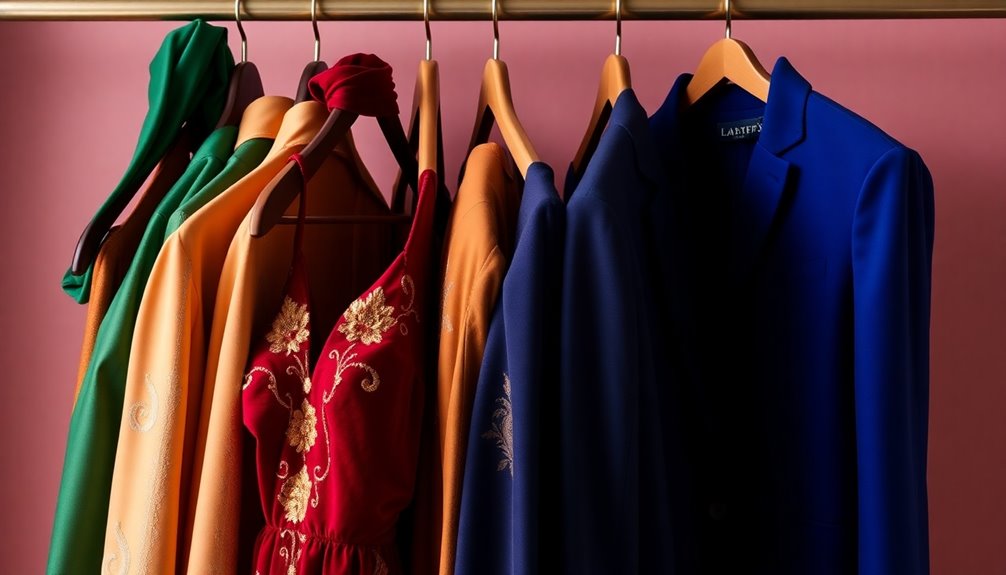
Renaissance colors have left a lasting mark on modern fashion, influencing everything from high-street brands to luxury designers. You'll find that high-street fashion translates runway looks into affordable pieces, making Renaissance-inspired colors more accessible. This trend allows you to wear shades reminiscent of those seen in high-end fashion shows, with earthy tones like terracotta and raw umber making their way into casual wear.
Fashion designers tap into Renaissance colors to craft stories within their collections, using hues like sapphire blue and terracotta to convey specific themes. They blend historical charm with modern sensibility, creating garments that honor the past while appealing to contemporary tastes. This interplay of light and shadow, much like chiaroscuro techniques, adds a dramatic flair to their designs, enhancing the overall experience through the use of umber tones that evoke both warmth and depth. The ability to understand financial metrics allows designers to make informed choices about materials and production processes, further elevating their collections.
Moreover, the elegance of the Renaissance also permeates wedding and formal fashion, where luxurious fabrics and intricate embroidery echo the opulence of that era. Modern bridesmaid dresses incorporate these historical elements, merging them with contemporary styles.
Ultimately, the psychological and aesthetic appeal of Renaissance colors resonates with you, offering a balance of warm earth tones and vibrant hues that evoke exploration and introspection in today's fashion landscape.
Incorporating Colors Into Outfits
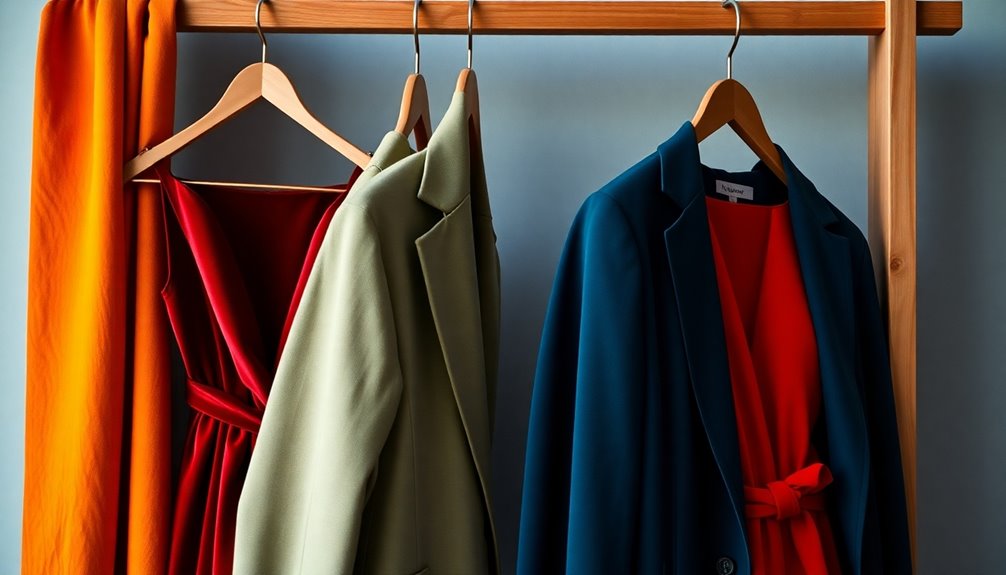
Embracing Renaissance colors in your outfits can elevate your style and express your individuality. Start by incorporating earthy tones like deep browns and forest greens into your minimalist wardrobe. A simple monochrome outfit can instantly pop with a terracotta scarf, while a sapphire blue brooch adds a subtle yet striking statement to your neutral office wear.
For business attire, consider adding a dash of emerald green or maroon through a tie or scarf to enhance your look. A sapphire blue suit or blouse can lend a regal aura to your professional ensemble, while rich burgundy or royal blue dresses provide sophistication. Modern Renaissance fashion often emphasizes deep jewel tones, making them perfect for creating striking business outfits.
Casual wear also benefits from these colors. Use bold tones like terracotta and emerald green in your casual apparel for a fresh vibe. Rich purples and soft pinks can create an elegant, laid-back outfit.
Don't forget the power of accessories. Incorporate gold accents through jewelry or embroidery to elevate even the simplest look.
Color Harmony and Psychology
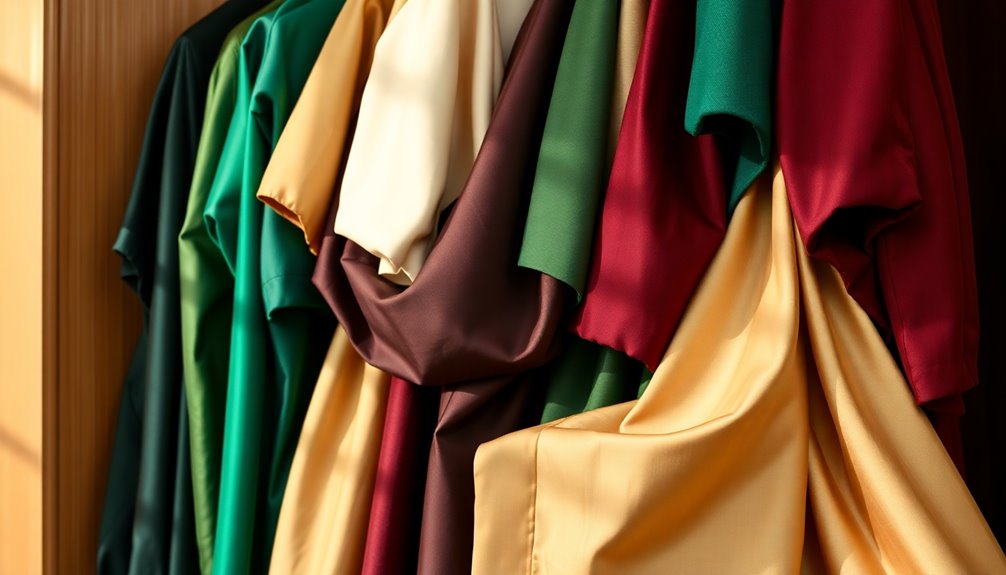
How do colors influence your mood and style? The Renaissance color palettes offer a fascinating insight into this connection. By balancing warm tones like deep browns with cool hues such as sapphire blue, you can create a harmonious look that reflects your personality.
Complementary colors enhance visual appeal, making combinations like blue and gold or green and red stand out. Layering shades of the same color adds depth, allowing you to express complexity in your outfits. Incorporating earthy tones conveys authenticity and reliability, perfect for a memorable brand identity. On the other hand, rich purples and soft pinks evoke opulence and romance, ideal for making a statement in luxury fashion.
Colors also carry emotional resonance. For instance, sapphire blue can instill a regal vibe, while terracotta brings rustic charm. The interplay of warm and cool tones fosters introspection, as seen in palettes like the Deep Renaissance.
Ultimately, being mindful of color psychology not only influences your mood but also enhances your style, inviting you to create a wardrobe that resonates with who you are. Embrace these insights to curate a wardrobe that truly reflects your essence.
Application in Fashion Segments
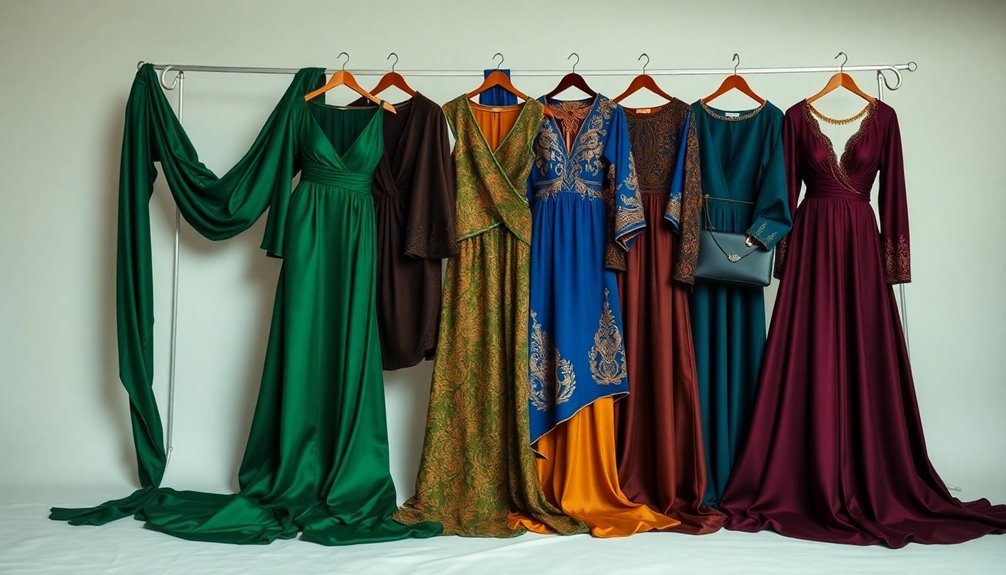
In contemporary fashion, the application of Renaissance color palettes spans various segments, each reinterpreting historical hues to fit modern styles.
In high-end and luxury fashion, colors like terracotta, sapphire blue, and gold evoke opulence and sophistication. Designers often use rich fabrics such as silk and velvet, incorporating intricate embroidery that pays homage to Renaissance art. This blend of historical influence and modern design creates regal looks that resonate with luxury, showcasing the luxurious materials favored during the Renaissance.
In casual and streetwear, earthy tones like raw umber and vibrant hues from Renaissance palettes offer a fresh, rustic charm. You can easily balance these colors with minimalistic pieces, adding striking statements to everyday outfits. High-street brands make these looks accessible, translating runway styles into affordable options.
For bridal and formal wear, Renaissance styles shine through with timeless elegance. Think full skirts and luxurious materials adorned with intricate lace. Rich jewel tones and soft pastels draw directly from Renaissance paintings, allowing for a customizable yet cohesive aesthetic.
Cultural Significance of Colors
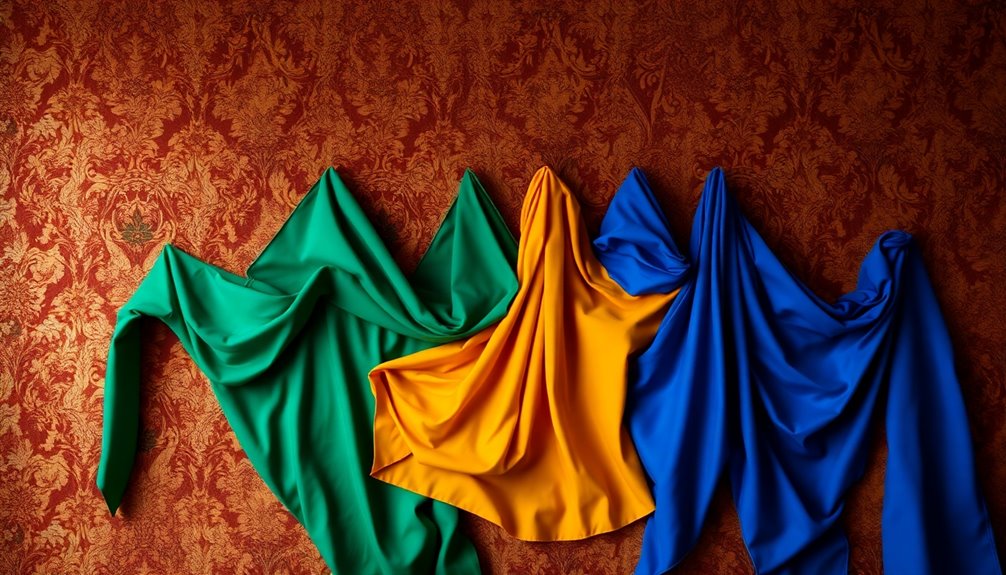
Colors from the Renaissance palette carry profound cultural significance, reflecting the values and aesthetics of a transformative period in history. During the Renaissance, artists recognized colors not just for their visual appeal but for their emotional and symbolic implications. Luxurious pigments, often derived from rare minerals and jewels, showcased an artist's stature and the era's opulence, as depicted in sumptuous fabrics like silk and brocade. These colors encapsulate the period's fascination with beauty and realism, influencing contemporary wardrobes in remarkable ways. You'll notice that Renaissance hues, from deep emerald greens symbolizing nobility to rich golds representing wealth, resonate in modern fashion. The warm, earthy tones provide balance, blending effortlessly into minimalist styles while allowing for bold statements. The techniques of sfumato and chiaroscuro used by Renaissance artists continue to influence how colors are blended and perceived in contemporary fashion. The legacy of color harmony achieved through careful blending remains present in today's design. Moreover, the use of essential oil properties in aromatherapy reflects similar principles of blending and balance that can enhance the overall aesthetic experience. Whether it's a bridesmaid dress or an elegant home decor choice, these historical colors inspire a sophisticated aesthetic.
Symbolism Behind Color Choices

The symbolism behind color choices in fashion can evoke powerful emotions and convey messages about identity and status.
Red, for instance, isn't just a vibrant hue; it represents passion and cheerfulness while historically indicating wealth, especially among men in courtly circles. When you wear red, you might feel that connection to high status and exuberance.
Blue, on the other hand, symbolizes royalty and wisdom. Its rarity, derived from lapis lazuli, makes it a statement piece associated with prestige. Expensive colors like blue can elevate your look and communicate importance.
Green represents wealth and rebirth, often seen in bright jewel tones. Incorporating green into your wardrobe can signify hope and renewal, creating a refreshing look.
Then there's black, which once symbolized humility but later became a color of power and fashion. Wearing black can convey sophistication and a connection to the elite, making it versatile for both everyday wear and special occasions.
Experimentation With Color Combinations
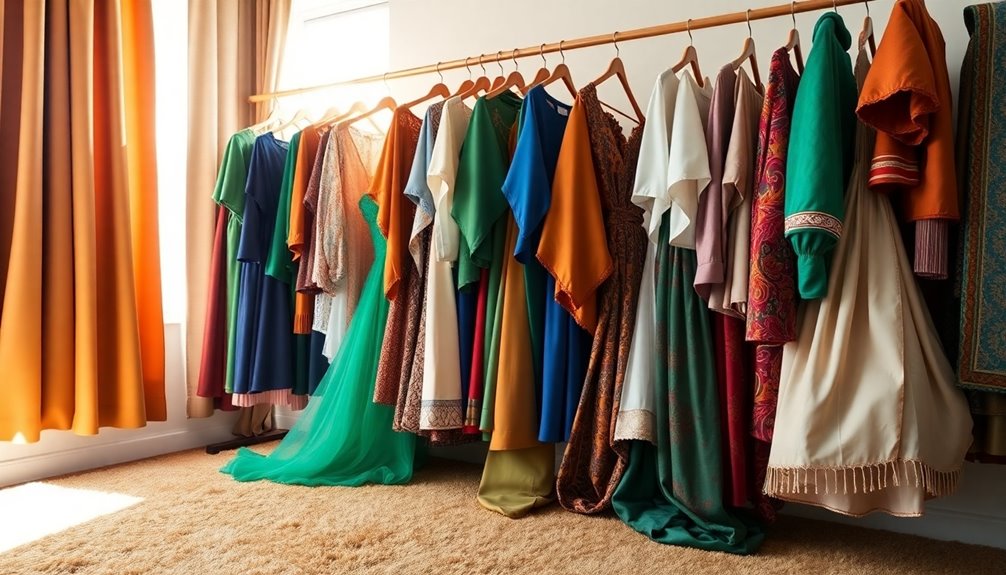
Experimenting with color combinations can transform your wardrobe into a vibrant expression of personal style. By incorporating historical colors like terracotta, sapphire blue, and emerald green, you can create outfits that reflect the richness of the Renaissance era. For instance, adding a terracotta scarf to a minimalist ensemble introduces warmth and character without overwhelming your look.
Balancing warm and cool tones is essential for achieving a harmonious aesthetic. Pair Rugby Tan with Desert Palm to create a soothing vibe, or mix sapphire blue with earthy Raw Umber for a regal yet grounded effect. These combinations not only enhance visual appeal but also convey moods, from rustic charm to sophisticated elegance.
High-end fashion often showcases rich purples, soft pinks, and golds, encouraging you to experiment with opulent tones in your everyday wear. Think about how a simple sapphire blue brooch can elevate a casual outfit into something more striking. Additionally, drawing inspiration from cultural decor can provide unique insights into color usage and combinations that resonate with historical significance.
Impact on Everyday Wear
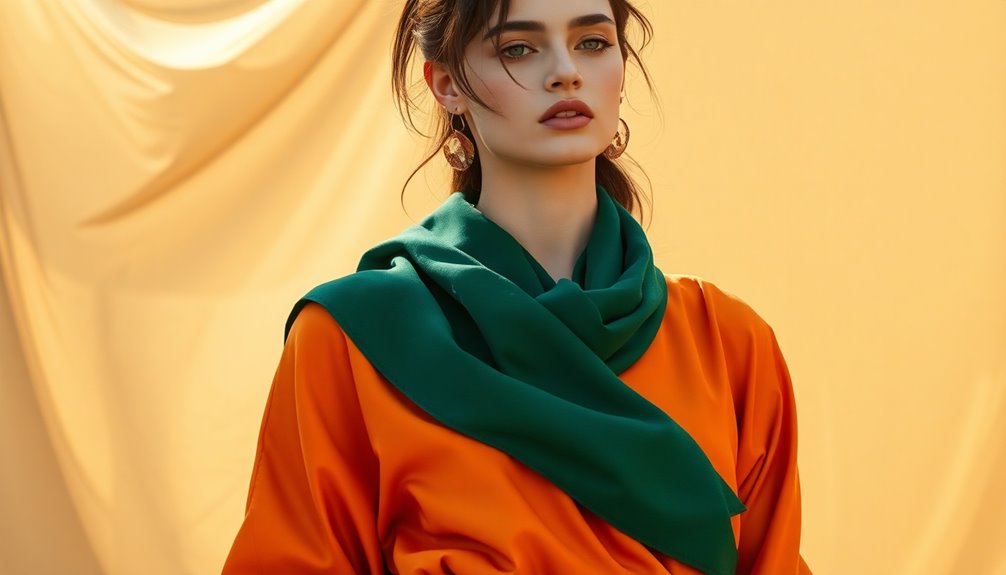
Renaissance colors are making a significant impact on everyday wear, breathing life into modern wardrobes. You'll find shades like terracotta, sapphire blue, emerald green, and gold adding vibrancy and richness to your outfits. These hues work beautifully in accessories like scarves and brooches, elevating minimalist styles to new heights. High-street fashion has embraced these colors, making them accessible and a staple in mainstream fashion. Incorporating Renaissance-inspired silhouettes, such as cinched waists and wide skirts, adds a touch of elegance to your look. You may notice corseted bodices and puffed sleeves reimagined in contemporary designs that provide drama. Additionally, the theatricality of Renaissance dressing influences modern fashion editorials, encouraging designers to adopt these vibrant color palettes. Decorative techniques like embroidery and beadwork also bring an artisanal flair to garments. As you explore the social and cultural significance of these colors, you'll realize they reflect a desire for luxury and refinement reminiscent of Renaissance social status. The fusion of historical elements with modern aesthetics appeals to a broader audience, making it easy for you to integrate this trend into your everyday wear. With options from both high-end designers and fast-fashion brands, you can effortlessly embrace the beauty of Renaissance color palettes.
Timelessness of Renaissance Palettes
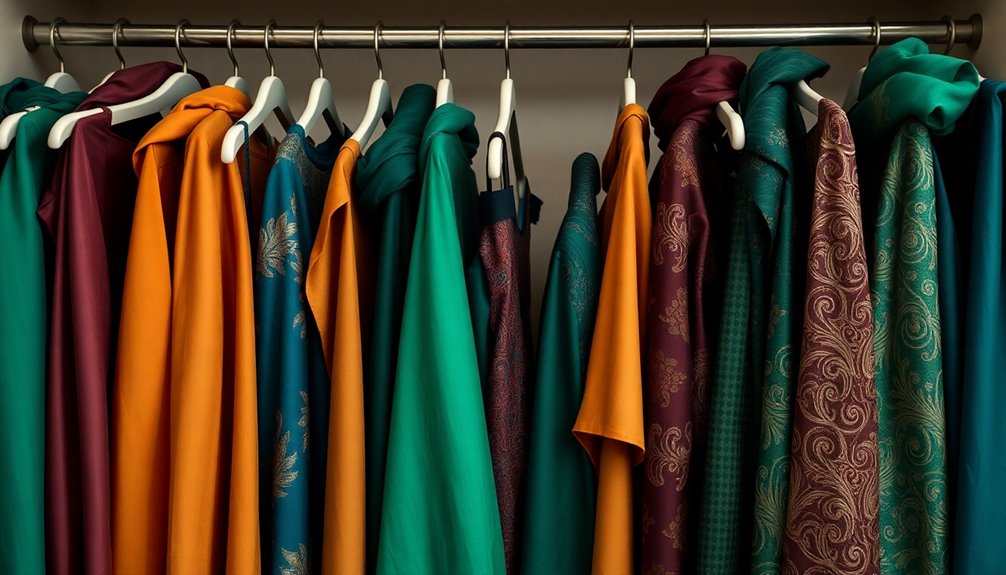
Timeless elegance defines the appeal of Renaissance palettes, as their rich colors continue to resonate in today's fashion landscape. Dominant hues like terracotta, sapphire blue, emerald green, gold, and crimson hold historical significance, reflecting the status of artists who used costly pigments derived from minerals and sometimes rare jewels.
These colors, along with earthy tones like deep browns and muted blues, create a luxurious feel that modern designers embrace.
Contemporary fashion infuses Renaissance influences into outfits by blending rich colors with sumptuous materials like velvet and lace. You’ll find collections at fashion weeks that narrate stories through these vibrant palettes. Designers are increasingly incorporating sustainable velvet production methods, ensuring that their luxurious fabrics are both environmentally friendly and ethically sourced. This commitment to sustainability does not compromise the opulence of their designs; rather, it enhances the narrative of each collection, creating a dialogue between the past and the present. As a result, contemporary fashion not only celebrates historical aesthetics but also paves the way for a more conscientious approach to garment creation.
Brands like Gucci showcase intricate embroidery and opulent fabrics, merging historical elegance with modern silhouettes.
Color combinations such as 'Golden Age' and 'Verdant Renaissance' harmonize warm and cool tones, while palettes like 'Regal Velvet' and 'Vibrant Florals' evoke both luxury and boldness.
The enduring appeal of these palettes lies in their ability to offer diverse choices, whether you prefer minimalist designs or striking statements.
Frequently Asked Questions
How Do Renaissance Colors Affect Different Skin Tones?
Renaissance colors can enhance your skin tone significantly. If you've got cool tones, opt for rich blues and purples. For warm tones, earthy hues and vibrant reds work wonders, creating a harmonious and flattering appearance.
What Are Some Affordable Sources for Renaissance-Inspired Clothing?
You can find affordable Renaissance-inspired clothing at stores like Forever 21, Old Navy, and Target. Thrift stores and Etsy also offer unique options, allowing you to create or modify outfits without breaking the bank.
Can Men Incorporate Renaissance Colors Into Their Wardrobes?
Absolutely, you can incorporate Renaissance colors into your wardrobe! Choose deep jewel tones or earthy shades to evoke that historical elegance. Pair these colors with modern styles for a refined yet contemporary look that stands out.
What Accessories Complement Renaissance Color Palettes?
To complement Renaissance color palettes, you can choose vibrant scarves, elegant jewelry, and luxurious bags. Earthy shoes and belts with intricate designs enhance your look, adding a sophisticated touch to your ensemble.
How Do I Mix Renaissance Colors With Current Trends?
To mix Renaissance colors with current trends, you can pair bold hues with modern neutrals, layer various shades, and incorporate rich textures. Don't forget to balance warm and cool tones for a harmonious look.
Conclusion
Incorporating Renaissance color palettes into your wardrobe not only elevates your style but also connects you to a rich artistic heritage. By embracing these timeless hues, you can express your individuality while enjoying the psychological benefits they bring. Experiment with bold combinations and subtle accents in your everyday outfits, allowing the symbolism behind each color to inspire your choices. Ultimately, blending modern fashion with Renaissance influences creates a unique look that stands the test of time.
